#angular momentum
Photo
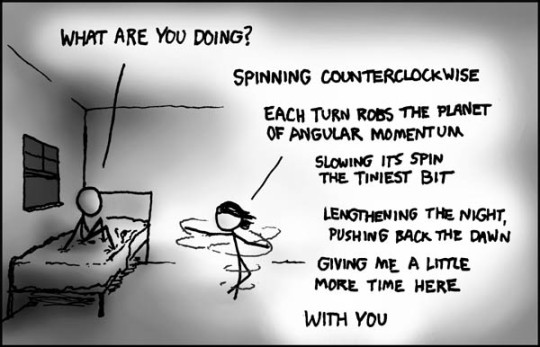
[thank you xkcd]
5K notes
·
View notes
Text
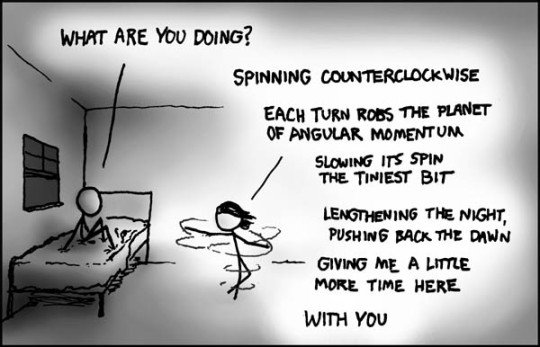
With reasonable assumptions about latitude and body shape, how much time might she gain them? Note: whatever the answer, sunrise always comes too soon. (Also, is it worth it if she throws up?)
Angular Momentum [Explained]
Transcript Under the Cut
[Cueball sits sideways on a bed under an open window in the corner of a room. He is looking at Megan, who is spinning fast, indicated with two large circles indicating where her arms that are spread far out rotate, as well as two smaller circles around her knees and feet. The bed sheets are clearly messed up, as if someone has used it for activities other than sleeping. It is night and dark gray outside the window, and inside the room everything is also gray but lighter. Behind the spoken text, the background is white, but fades to the darker gray at the edges. There is also different gray shading in different parts of the room.]
Cueball: What are you doing?
Megan: Spinning counterclockwise
Megan: Each turn robs the planet of angular momentum
Megan: Slowing its spin the tiniest bit
Megan: Lengthening the night, pushing back the dawn
Megan: Giving me a little more time here
Megan: With you
111 notes
·
View notes
Photo
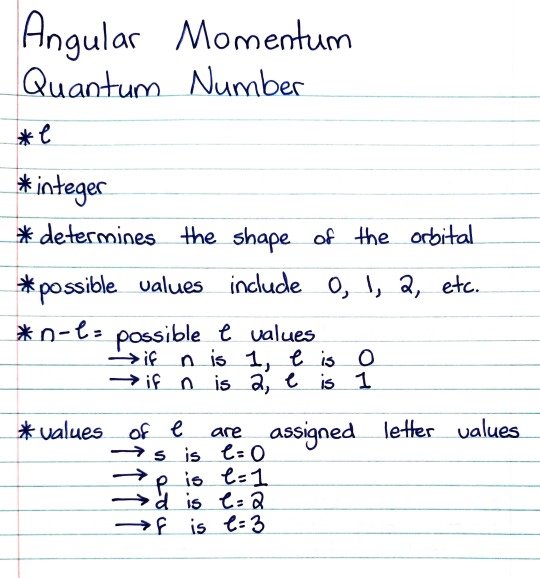
#studyblr#notes#chemistry#chemistry notes#chem#chem notes#chemistry ex#chemistry example#chem ex#chem example#mcat#mcat studyblr#mcat chemistry#mcat chem#chemistry 1#chemistry 2#chemistry I#chemistry II#mcat chemistry example#angular momentum#quantum number#angular momentum quantum number
4 notes
·
View notes
Text
Why Dinosaurs Would Make Good Ice Skaters
Why is this a question? I don’t remember the reason. Perhaps my brother-in-law mentioned dinosaurs and asked what they would have been good at, so I said, “Ice skating,” so that’s where we are. In the 21st century though some people live in the past. With the dinosaurs. Okay, okay, I’ll stop rambling and jump directly to the conclusion.
It is not without the lack of a doubt that dinosaurs would…

View On WordPress
#angular momentum#Bible#dinosaur#fun#ice#ice skates#ice skating#moment of inertia#momentum#physics#silly#skates#theory
0 notes
Text
Torque and Angular Momentum

In the fascinating world of physics, rotational motion takes center stage, offering a wealth of insights into the behaviour of objects as they spin and twirl around an axis. Two indispensable concepts in this realm are torque and angular momentum.
0 notes
Text
New video: Elliptical motion from Newton's law of gravitation.
[Click here for a PDF version of this post]
We found previously that
\begin{equation}\label{eqn:solarellipse:20}
\mathbf{\hat{r}}’ = \inv{r} \mathbf{\hat{r}} \lr{ \mathbf{\hat{r}} \wedge \Bx’ }.
\end{equation}
Somewhat remarkably, we can use this identity to demonstrate that orbits governed gravitational force are elliptical (or parabolic, or hyperbolic.) This ends up being possible because…

View On WordPress
#angular momentum#calculus#conic equation#directrix#dot product#eccentricity#Geometric Algebra#integration#Kepler&039;s laws#Newton&039;s law of gravity#wedge product
0 notes
Text
Angular Velocity
Introduction
Angular velocity is a key concept in rotational dynamics, a subfield of physics dealing with the movement of bodies around a pivot point. Essentially, it is the rate of change of an object’s angular displacement over time.
Defining Angular Velocity
Angular velocity is usually denoted by the Greek letter $\omega$. In its simplest form, for an object moving in a circular path,…
View On WordPress
0 notes
Photo
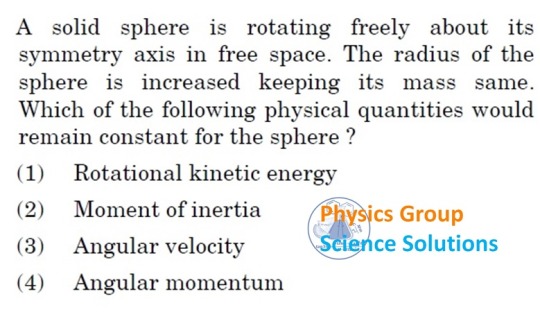
#solid#sphere#physics#solutions#rotating#freely#symmetry#space#radius#mass#physical#quantities#rotational kinetic energy#moment of inertia#angular velocity#angular momentum
1 note
·
View note
Text
You’ve fallen for my trap!
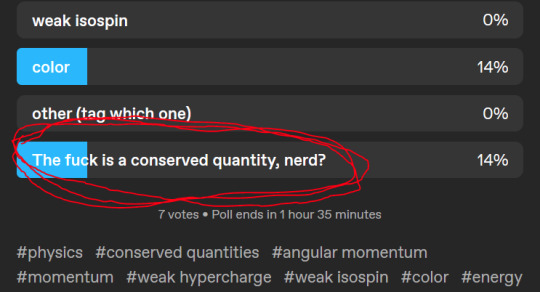
So, someone took that option in my poll, giving me an excuse to rant about conserved quantities, and Noether’s Theorem!
A conserved quantity is a mathematical value, which, over the course of a transformation, is, well, conserved.
These transformations range from coordinate transformations to processes, like decay or scattering.
I won’t go into the more complicated ones, like the weak hypercharge and isospin nor color, but i will explain how coordinate transformations and conserved quantities follow from one another. This fact was discovered by Emmie Noether, and it states that for every symmetry transformation of a system, a conserved quantity must exist which describes it.
A couple examples:
If a system’s equations don’t change with a translation in time, energy is conserved. If energy is conserved, the equations describing the systems are invariant under translations in time.
If a system’s equations don’t change with a translation in space, momentum is conserved, and vice versa once more.
An invariance to rotation about an axis corresponds to conserved angular momentum.
This theorem is well known among physicists, but it’s beauty is largely unknown to the wider public, and in many opinions, mine included, it’s actually the most beautiful result in all of physics.
Whenever there’s a conserved quantity, there’s a corresponding symmetry, and whenever there’s a symmetry, there’s a corresponding conserved quantity.
Always.
#physics#noethers theorem#energy#time#momentum#coordinate space#rotation#angular momentum#conserved quantities
1 note
·
View note
Text
Dot Physics: The Crazy Science of Drone Flight
Dot Physics' Rhett Allain explains the science behind how drones fly.
0 notes
Text
youtube
#coefficient of restitution#collision experiment#linear momentum physics#angular momentum#elastic collision#inelastic collision#amazing science experiments#etoos india#Youtube
0 notes
Text
everyone knows about “spoons”, but...
...for most people it’s an abstract concept. kinda fuzzy. we all feel like we understand what it’s like to have (or not have) spoons, because we’ve felt it in our own lives—if we’re neurodivergent, trauma survivors, whatever. but what *is* a “spoon”?
I think I have an idea of what a “spoon” is, very roughly, on a physical level. I think it’s something I might be able to semi-quantify: a “spoon”, I suggest very tentatively, is a quantized measure of how much angular momentum the human body possesses at any given moment.
I suggest that the human body is capable of saving up angular momentum, in a variety of subtle ways. We might speak of “potential” and “kinetic” angular momentum in the human body—"potential” angular momentum being stored up through some modification of the natural cycles of human physiology, and “kinetic” angular momentum being determined by the motions of the human body as a physical object or collection of objects, rotating around various axes.
to put it very roughly, the “spoon” is like one single unit or packet of “get up for one more round”. we tend to think of our activities as being sequences of steps or tasks, and if you’re out of “spoons”, you don’t want to do *any* activity. you simply want to rest and recharge. but if you feel like you’ve got one more job in you, then you’ve got a “spoon”. one spoon.
anyway, I’m going to have to think about this one a lot more. it’s a rather outlandish idea.
~Chara of Pnictogen
0 notes
Text
What is Conservation of angular momentum?
You can use the assistance of angular training in Hyderabad to discover how the conservation law of angular momentum functions. You will be assisted in learning the conservation law with the use of examples in this angular online tutorial. You will also receive angular certification as a result of this programme once you have successfully completed it. What is Conservation of angular momentum?
0 notes
Text
I have made a scientific discovery which embarrasses every physicist and most scientists that have ever existed and the fact that this is difficult to believe does not make me wrong. Only a typical classroom ball on a string demonstration doing 12000 rpm can make me wrong.
1 note
·
View note
Text
No one has ever made me cry the way physics numericals have.
#failing tomorrow#what the fuck is angular momentum centripetal acceleration tension and what not#physics#exams#studyblr#desiblr#chaotic academia#desi#dark academia#humor#desi academia#memes#study memes#physics memes
511 notes
·
View notes
Text
Radial vector representation, momentum, and angular momentum.
[Click here for a PDF version of this post], and here for a video version of this post.
Motivation.
In my last couple GA YouTube videos, circular and spherical coordinates were examined.
This post is a text representation of a new video that follows up on those two videos.
We found the form of the unit vector derivatives in both cases.
\begin{equation}\label{eqn:radialderivatives:20}
\Bx = r…
View On WordPress
0 notes